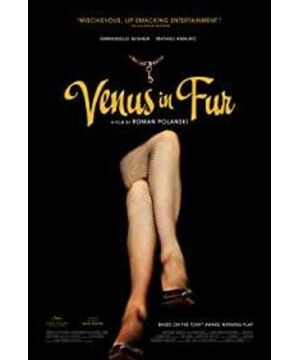From the beginning of the film, the camera swept across the gloomy woods, turned left and entered an unknown small theater, opened the theater door, and saw the audition card of La Vénus à la fourrure hanging slantingly on the hall door.
The opening of the seamless long shot in just a few seconds, the audience is under the control of the old fox Polanski, and enters a drama uneasily.
96 The six-minute plot, 90 minutes is based on the delicate lines of the actors and actresses, the theater scene is on and off the stage, the lights and props are switched in various mobilizations, and a good show is easily created.
The five stars of this movie lie in that the director, in addition to continuing one of the props in the killing, the "telephone", also passed, every time the two leading actors change their clothes, every time they get on and off the stage, every time the lighting is dispatched, little by little, the male and female There was a joke in their relationship, and those in power were a little bit stolen by the weak (seemingly) who were good at navigating power. As the film progressed, the director threw a question to the audience, "Who is the weaker and who is the stronger?"
Often in the relationship between men and women, most people default to the fact that the woman is the weaker and the man is the sovereign strong. . This seems to be the default rule of the game in a patriarchal society. And this Venus of fur is a sour gift from Roman Polanski to feminism at the age of 80.
At the beginning, the male protagonist Thomas stood on the stage while smoking a cigarette while talking to the phone, complaining about the day's casting, without any gain, and the female protagonist still doesn't know where to go. At the end of the film, still on the stage, the male protagonist is seduced by Vanda step by step. In the end, he completely loses his personality and is tied to the cactus tree (chicken tree) that symbolizes male power in the scene props. The male protagonist seems to have transformed from a chauvinist to a slave who has lost his personality and power, and even a person who has been deprived of his gender at the end.
And the heroine, from weak to strong, and then from strong to complete power, just like her appearance at the beginning of the movie, dragging her luggage at the exit of the theater-completely weak. Then, Vanda cried and made trouble, begging the male protagonist to give her a chance to interview. This is the first time a woman is using her own advantages to control the male protagonist. Vanda, who happens to have the same name as the heroine of La Vénus à la fourrure, is like a fairy or a witch who comes in the night. Saying she is a fairy, she can keep pulling out all kinds of costumes and props from her bag. Saying she is a witch, under her step-by-step temptation and manipulation, the male protagonist went from being tall and powerful to finally being nailed to a cactus tree, and he was a witch.
From the time Thomas promised Vanda to let her audition, the play was doomed to be stolen.
And the soundtrack of the film is also excellent. Add more naughty vibes to this comedy.
And Mathieu Amalric's performance is worthy of the name of the best French actor.
View more about Venus in Fur reviews









